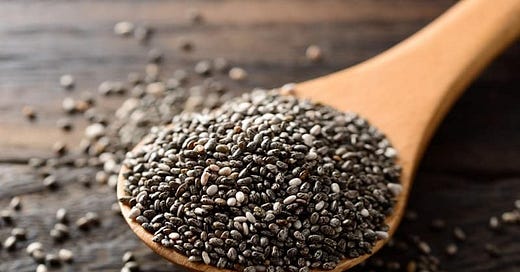Chia Seeds
One unfortunate consequence of Joe Pedatt’s invention of Chia Pets in 1977—animal shaped ceramic vessels in which sprouting Chia grass that served as a furry green pelt—was that it created an aura of gimmick around Chia Seeds, an ancient and valuable food in central America. The Chia plant, a Salvia from the mint family, was a staple people of the Aztecs, along with beans and maize, a pillar of their diet, providing minerals, B vitamins, and a panoply of essential fatty acids to its consumers.
In pre-contact times the cultivation of the Chia plant spread north out of Mexico into California, New Mexico, and parts of Arizona. The Kumeyaay people of Southern California used them for a favorite beverage: “With sticks girls beat the chia seeds from bushes into a basket. Then they parched them over the fire, ground them, added water, and a little salt which they gathered from the margin of the Salton Sea, then drank the refreshing preparation,” [“Three Indian Girls present scenes of Primitive Live at Art Center Auditorium in Balboa Park,” The San Diego Union (October 11, 1925), 14.]
Yet even the most experimental California cultivators in the heyday of new introductions into fields and orchards passed on adopting Chia as a potential crop. Indeed interest in the Chia among American agriculturists did not emerge until 1938 when chemists suggest that oil extracted from Chia seeds might be used as a substitute for tung oil. The National Paint, Lacquer, and Varnish Association, planted test plots of Chia in Hardin County, Texas to determine whether an alternative to the nut oil from the Chinese Tung Tree might produce a similar clear hard transparent coating.[“Stienhagen Experiment,” Beaumont Sunday Enterprise (April 24, 1938), 20.] These experiments proved somewhat successful. But the shattering of seed pods posed a challenge for efficient harvesting.
Anglo-American consumption of Chia Seeds did not occur until the rise of the Health Food store as a fixture of commercial culture in the United States in the first half of the 1960s. Dunn’s Health Mart on South Main Street in Tulsa was the first such store in the country to ask in its advertising, “Have you tried Chia Seeds? Ancient energy food rediscovered.” [Tulsa Daily World (August 1, 1964), 21.] The health food movement in the 1960s was enamored with the notion of the nutritional drink—a beverage that could stand in for a meal. The diet industry would take this notion up with the metrical shakes. Chia seeds were central to the experiments to create the nutritive beverages.
Chia seeds are hygroscopic, absorbing over 10 times their weight in water and excreting a gel. This gel because the matrix of many of the nutritive drinks—the substance of a shake. Indeed, the gel, which contained much of the chemistry of the seed, drew the attention of NASA’s nutritionist who tweaked it in their effort to create space meals for astronauts.
It was in the midst of this Chia moment that Joe Pedatt launched his grow your own pet toy, the Chia Pet. Some schools embraced the Chia Pets as a means of getting students to attend to plant germination and growth. But truth be told, it was a gimmick and its educative virtue was marginal.
Agricultural engineer Wayne Coates began the mass marketing of Chia Seeds as a food in the 1990s. He was one of the earliest adopters of the phrase “superfood” to describe certain greatly nutritious edible plants. Coates’s Chia: the Complete Guide to the Ultimate Superfood converted numbers of celebrities to the seed, and their advocacy in turn made it increasingly popular. There was little processing of the seed before consumption. It was dried, used as a cereal, sprinkled on salads, and doused with water to create mucilaginous Chia drink. This is pretty much how it is consumed in the United States today.





Thanks for this history, David--I've been an on-and-off consumer of chia seeds since the early 2000's, and always liked them. When I'm on a smoothie kick, they're almost always an ingredient. Chia pudding is a favorite, and, since I'm a big fan of nuts and seeds, I've used them in salads, etc. I remember the chia pet days (never had one), and remember how interesting it was to me that they suddenly came into vogue as a serious health food. But I never knew the history. Once again, you've enlightened (and delighted)me!